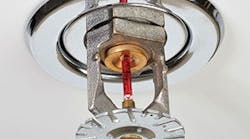Need to sprinkle part of your building but concerned about freezing temperatures? A dry pipe sprinkler system will provide the coverage you need without the risk of burst pipes.
While wet pipe sprinklers are the most common form of fire protection, they cannot be used in temperatures of 40 degrees F. and below. The standard way to sprinkle exposed building areas such as an open garage, freezer storage, or unheated spaces is to install a dry pipe sprinkler system.
Despite their advantages, be aware that dry pipe sprinklers have separate maintenance, testing, and installation requirements to ensure proper performance.
How They Work
Unlike a wet pipe system, dry sprinklers are free of water until a fire is detected.
“A dry pipe sprinkler system is designed so that the piping itself is filled with pressurized air instead of water,” explains Ken Isman, vice president of engineering for the National Fire Sprinkler Association. “The pressure from the air holds a valve closed that has water behind it. The sprinkler actuates during a fire, causing the air pressure to drop. This removes the pressure from the valve, which releases the water into the pipes.”
These additional steps create a delay of up to 60 seconds between activation of the sprinkler and when water reaches the sprinkler head. While there’s a small chance a fire can continue to grow during these additional moments, this delay is better than having no fire protection at all.
Testing and Maintenance
Even though dry pipe sprinklers don’t have active water in the system, you need to be vigilant about condensation.
“The challenge with these systems is that once you fill them with water during a test, you have to get all of that water out,” says Isman. “And even if you completely drain the system, there is still humidity in the air. When you compress air and place it in a pressurized system, the water tends to fall out of suspension and accumulate.”
While it may seem like a miniscule amount of water, frozen condensate can plug the sprinkler main feed, cautions George McHugh, an owner of AGF Manufacturing, which specializes in fire sprinkler accessories. The plug will prevent the valve from tripping during a fire because it hinders the air pressure from dropping properly. Even if the valve trips, the ice can delay or block the water flow.
It is best to drain the system every quarter to remove moisture, advises McHugh. This can be done by opening drains (drip pans) that are built into low points within the system. Perform a valve trip test annually, which can be done without releasing water, and a full flow trip test every three years.
“Because they collect moisture and that has to be dealt with to prevent freezing, there is a higher level of maintenance associated with dry pipe systems,” McHugh says. “However, it’s more cost-effective to put in a dry pipe system than to condition the space.”
Long-Term Costs
If you need to install new dry pipe sprinklers, account for a greater upfront investment than wet sprinklers. “From an installation standpoint, dry pipe sprinklers are more expensive because you have to pitch the pipes to help keep water out of the system, which accounts for more labor,” Isman says.
Dry pipes are also more susceptible to decay over their lifecycle. “The piping is generally made of steel and the combination of steel, air, and water encourages corrosion,” notes Isman. “It’s highly likely that the piping would have to be replaced in a dry pipe system more often than a wet one.”
Routinely complete visual inspections to spot vandalism, damage, or corrosion. You can also have an inspector use an ultrasonic scanning device to detect ice or corrosion blocks without having to cut into the pipe to determine if there’s a problem.
Despite these additional measures and costs, dry pipe sprinklers provide a simple solution for difficult-to-sprinkle areas.
Jennie Morton ([email protected]) is associate editor of BUILDINGS.


